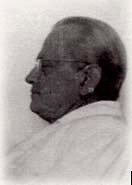 Dogu
Bankov
Dogu
Bankov
1884-1970
An artist's significance is usually measured by the creative product of
their life time,
plus their ability to present ideas to influence their environment. To
this Bankov never came close; with only three exhibitions before 1960.
Furthermore, not one of the exhibitions received anticipated attention,
despite Baden Baden in 1927, which made him the victim of some very harsh
words and ridicule from the press.

1a,b. To leave the country
73x64, 53x39,5. Not dated. Unsigned but during the years in the Russian Museum in New
York it was accompanied by an attestation by Dogu Bankovs sister, Vera
Bankova. Photographs from the exhibition in Baden-Baden shows this work mounted together with the photograph of the little boy as we
have chosen to do here.
However, what wasn't mentioned was that a series of works were sold from
the exhibition - three of which were bought by The Baden Art Museum. This
particular collection of Bankov's work is primarily due to the inexhaustible
Amchiel Goldstein, Bankov's friend of many years (if anyone could indeed
be called a friend of the shy, recluse Bankov). Goldstein - originally
known as Vladimir Schukschin - came from Kazan in Russia. Partly due to
the war in Europe, partly to his Jewish connection, but also on the grounds
of pure economical interest, Goldstein lived an unsettled life until his
death in New York in 1954. Since Goldstein was one of the founders of
the small, but very interesting Russian museum in New York, a great deal
of his collection entered the permanent collection. Even today, you can
see works by the Constructivists and the 1920's Avantgarde - for example
Alexandr Scheyenkow, the brothers Mikhail and Abram Weksler, and Vladislav
Strzeminski (whom Bankov greatly admired and was partly influenced by).
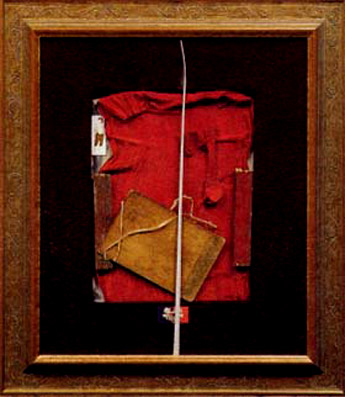
3. Black theatre
60,5x53. Title made by Amchiel Goldstein around 1950. Unsigned. Not dated.
Probably
this work has been made in the mid-1920s but as so often in Bankovs works
elements are added or taken away over the years. In this work there are
many loose elements -including the photo of the four officers (of which
we know for certain that at least one of them was Bankovs lover. The fact
that the photograph falls around in the picture for every new mounting
could perhaps give the viewer some interesting ideas - which we will not
mention here.
After Goldstein's death around seventy works by Bankov were removed from
the
museum's permanent collection, and then in 1973, three years after Bankov's
death, the works were returned to the Goldstein family. The reasoning
at that time for the removal and return of Bankov's works, was that due
to his Bulgarian identity, the presence of his works in the Russian Museum
proved difficult. Furthermore, there were those who considered Bankov
a Dadaist, which was not a profile the museum appreciated. However the
advantageous result was that the works were returned to Europe by the
Goldstein family, in particular Anna-Eliz Janco-Mehlik who placed a number
of the works in Bulgarian museums, and also this important collection
in The M.K. Ciurlionis National Museum in Kaunas, Lithuania.
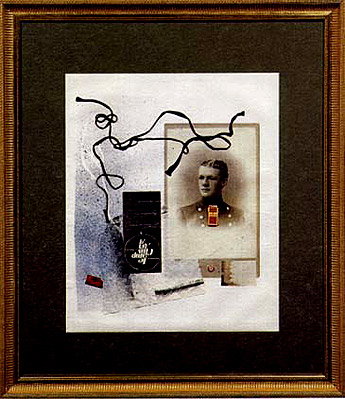
7. I am beginning to understand
101x87. Unsigned. Dated 1925 on the back.
But according to some of Goldsteins
letters a few formerly incorporated elements were later omitted. The title is
questionable as, first of all, it is only mentioned in Goldsteins letters from the
1930s, secondly; understand what? Bankov was probably going through a
personal crisis as no work from Bankovs hand dates from the years between
1917 and 1921. A photograph from Bankovs almost empty studio in 1917 shows
this work - unfinished - on the wall surrounded by black cloth.
Perhaps the most disappointing aspect of the transfer was the loss of
almost all of Goldstein's notes on the works. From alternative sources
and photographs found after his death in 1970, it seems that Bankov worked
for his own amusement. A number of photographs on exhibitions and a few
amateur snapshots taken in his studio reveal that some of the elements
from his collages reappear in much later works – which largely indicates
that earlier works were destroyed. Nevertheless, we can see that the elements
in the collages, and especially the incorporated photography, has a strong
personal connection. People who in one way or another had some form of
personal connection to Bankov, pop-up continuously in the photographic
content of the collage. Then later they risked being removed, as the relationship
between the subject and Bankov changed.
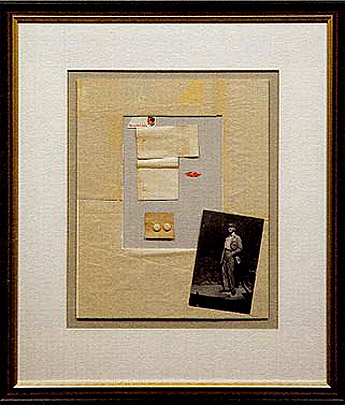 13. Party for Stage
13. Party for Stage
85x73. Unsigned. Almost invisible dated 1950 at the back.
For once we know that
the title is Bankovs own. The actor portraied is Pierre St. Luchien-Aubry,
well known in pre-war Paris. As he is included in a number of Bankovs
works we have reason to believe that Bankov was more than a little fascinated
by him. However, this came to nothing, but he is mentioned on a few occasions
in letters to Vera Bankova as Miss Aubry (!) and described as a kind of
party-lion, hence the title.
Much
of the latter indicates that Bankov could never have been a part of the
Dadaist milieu. The Dadaist's cold approach and opposition to society
at large will always be far removed from Bankov's love of the narrative
and sometimes almost private world of presentation. In fact, seen in the
light of the general role of the artist, who supplies works for public
presentation, who personally and economically builds up a career - even
if it is in the Dadaist spirit of protest and opposition - one could question
whether Bankov wanted to be an artist at all.
Today when the few museums and collections owning Bankov's art define
the work as Dada, the definition is based mainly on the material content
of the collage and the time-span of the early experimental works. We know
Bankov met Tristan Tzara, a Rumanian who was one of the founders of Dadaism,
at least once. However, as yet, there has been no indication that this
meeting was particularly successful. The poet Tristan Tzara's statement
that "The most important is solemnly bound to the unknown" is
hardly compatible with Bankov's fondness for personal narrative.

20. No Title
79x60,5. Unsigned. No date.
The Bulgarian-Jewish writer Atanas Castmann was married
to Bankovs sister Vera Bankova for less than a year (1931). Atanas Castmann
was a great admirerer of Karl Liebknecht and this picture was presented
to Castmann as a gift. Bankov rarely showed or presented his art work
to anyone but Castmann remained a friend until Castmann’s death
in 1945.
Perhaps Bankov would have felt more comfortable with the ideas of Hugo
Ball, but after the 1st World War when Bankov visited Zurich, the Cabaret
Voltaire, which Ball started as the Dadaist's first rendezvous, was already
closed down. Ball had stepped down for the true leader Tzara, supported
by the brothers Marcel and Georges Janco. It is difficult to speculate
the consequences on Dadaism if Bankov had arrived earlier in Zurich and
participated with his more personal, softer approach, but the answer lies
as much in his personality.
Bankov's expression was almost naive, he was in no way a leader and took
little pleasure in presenting himself as an artist, neither to the public
or colleagues. However, we do know that Ball and his wife Emmy Hennings
did see some of Bankov's works, because in a letter to Bankov in 1923
they write enthusiastically about his collage and wish him luck with his
oncoming exhibition in Baden Baden (This exhibition was, as we know, delayed
and did not take place until 1927, when Ball was long dead. None of the
Dadaists were present or mention the exhibition at all).
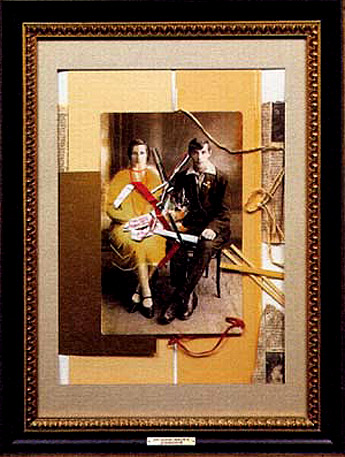
25. The Housekeeper
82,5x62,5. Unsigned. No date. Purchased by Ciurlionis Museum in1999.
Bankov himself
could never afford a housekeeper but this lady was from a family living
close to Bankov in his Sofia years. The photo Bankov took on her wedding
day.
Bankov's income came almost entirely from portraiture; unsigned watercolours
executed on commission for very little money. Or it was photography, also
made to order and without exception unsigned by the photographer. We don't
know how he began with photography, but it can perhaps be linked to his
friendship with the
Bulgarian Princess Evdokia who was a keen amateur photographer. It is
worth
mentioning that this friendship made difficulties for Bankov when the
princess was shot in 1944 and new rulers took over. Even in 1961, when
Bankov was awarded The Kyrill and Metodius Medal for Culture, his friendship
with the princess surfaced and he prepared to leave Bulgaria for good.
A couple of years later he settled in Budapest, but the past few years
had disappointed him, he failed to learn the language, had little contact
with his homeland and little sympathy with Hungarian culture. Bankov felt
lonely and uninspired. Today, there are very few works from this period,
and those which did emerge after his death display a strong influence
from American and British Pop-art. Such art, even in relatively liberal
Hungary, could create great problems for the artist.
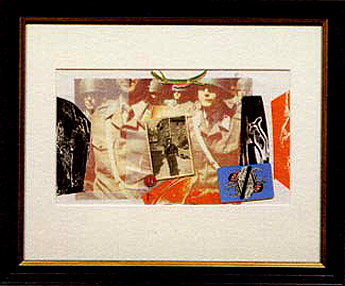
14. Bashful Men and
Ship
36x46. Unsigned. No date but completed in Budapest as late as 1964.
The relatively few works from his Budapest-years are almost all influenced by British Pop-art which could indicate that it may date from
just after WWII - when Bankov tried to do works that could reach a greater
public. As so often before Bankov gives small hints of his view on military
life and society in general.
What is Bankov's significance for us today? Art-historically, he is interesting
due to his connection with Dadaism and the Russian Constructivists. Bankov's
art creates curiosity concerning concurrent events in greater Europe.
Even in his earlier work from Paris one can see a unique and individual
style. Could this have come from the academy in Sofia and, if so, what
became of his fellow students? Was he alone? Not likely, but this could
be the beginning of a new and exciting journey through 20th century art
history.
Dr. Bernhard Hölchner
Baden Art Museum